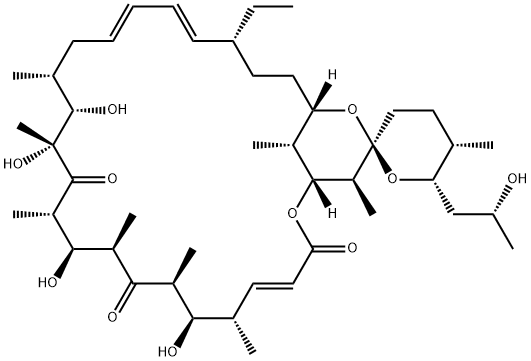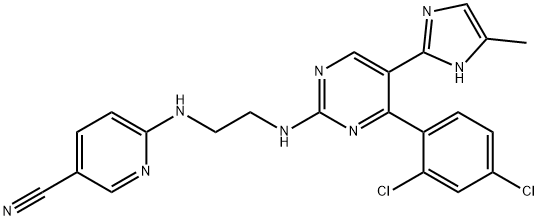OLIGOMYCIN A
- CAS NO.:579-13-5
- Empirical Formula: C45H74O11
- Molecular Weight: 791.06
- MDL number: MFCD00065705
- EINECS: 209-437-3
- SAFETY DATA SHEET (SDS)
- Update Date: 2024-11-17 19:25:39

What is OLIGOMYCIN A?
Description
Oligomycins are macrolides created by Streptomyces species that can be toxic to other organisms. Different oligomycin isomers are highly specific for the disruption of mitochondrial metabolism. Oligomycin A, a dominant analog of the isomers, is an inhibitor of mitochondrial F1FO ATP synthase that induces apoptosis in a variety of cell types (average GI50 = 270 nM). Oligomycin A exhibits antifungal, antitumor, and nematocidal activities, but has poor solubility in water and other biocompatible solvents, which limits its clinical application.
Chemical properties
White powder
The Uses of OLIGOMYCIN A
Oligomycin A is a macrolide with fungicidal activity isolated from Streptomyces species.
The Uses of OLIGOMYCIN A
Oligomycin A is the dominant analogue of a class macrocyclic lactones isolated from selected strains of Streptomyces sp.. Oligomycin A is an inhibitor of mitochondrial F1F0-ATPase. It induces apoptosis in a variety of cell types, makes cells more susceptible to cell death, and also leads to a switch in the death mode from apoptosis to necrosis. Oligomycin A exhibits a broad biological profile including antifungal, antitumour and nematocidal activities.
The Uses of OLIGOMYCIN A
Oligomycin A is the dominant analogue of a class of macrocyclic lactones isolated from selected strains of Streptomyces sp.. Oligomycin A is an inhibitor of mitochondrial F1F0-ATPase. It induces apoptosis in a variety of cell types, makes cells more susceptible to cell death, and also leads to a switch in the death mode from apoptosis to necrosis. Oligomycin A exhibits a broad biological profile including antifungal, antitumor and nematocidal activities.
What are the applications of Application
Oligomycin A is a mitochondrial F1F0 ATP synthase inhibitor and uncoupler of oxidative phosphorylation, active in vivo and able to induce apoptosis in a variety of cell types.
storage
-20°C
References
[1]. jastroch m, divakaruni as, mookerjee s, et al. mitochondrial proton and electron leaks. essays biochemistry, 2010, 47:53-67.
[2]. shchepina la, pletjushkina oy, avetisyan av, et al. oligomycin, inhibitor of the f-0 part of h+-atp-synthase, suppresses the tnf-induced apoptosis. oncogene, 2002, 53: 8149-8157.
[3]. salomon ar, voehringer dw, herzenberg la, et al. understanding and exploiting the mechanistic basis for selectivity of polyketide inhibitors of f0f1-atpase. proceedings of the national academy of sciences of the united states of america, 2000, 97(26): 14766-14771.
[4]. alexander r, adina v, ivan b, et al. overcoming intrinsic multi-drug resistance in melanoma by blocking the mitochondrial respiratory chain of slow-cycling jarid1bhigh cells. cancer cell, 2013, 23(6): 811-825.
Properties of OLIGOMYCIN A
| Melting point: | 150-151℃ |
| Boiling point: | 886.3±65.0 °C(Predicted) |
| Density | 1.14 |
| storage temp. | Sealed in dry,Store in freezer, under -20°C |
| solubility | Soluble in DMSO, ethanol or acetone |
| form | powder |
| pka | 12.52±0.70(Predicted) |
| color | white to off-white |
| Merck | 13,6902 |
| BRN | 5702132 |
Safety information for OLIGOMYCIN A
| Signal word | Warning |
| Pictogram(s) |
 Exclamation Mark Irritant GHS07 |
| GHS Hazard Statements |
H302:Acute toxicity,oral |
| Precautionary Statement Codes |
P264:Wash hands thoroughly after handling. P264:Wash skin thouroughly after handling. P270:Do not eat, drink or smoke when using this product. P330:Rinse mouth. |
Computed Descriptors for OLIGOMYCIN A
| InChIKey | MNULEGDCPYONBU-WMBHJXFZSA-N |
New Products
(S)-3-Aminobutanenitrile hydrochloride 4-Methylphenylacetic acid N-Boc-D-alaninol N-BOC-D/L-ALANINOL Tert-butyl bis(2-chloroethyl)carbamate N-octanoyl benzotriazole 3-Morpholino-1-(4-nitrophenyl)-5,6-dihydropyridin- 2(1H)-one Furan-2,5-Dicarboxylic Acid S-2-CHLORO PROPIONIC ACID ETHYL ISOCYANOACETATE 2-Bromo-1,3-Bis(Dimethylamino)Trimethinium Hexafluorophosphate 4-IODO BENZOIC ACID 3-NITRO-2-METHYL ANILINE 1-(2,4-DICHLOROPHENYL) ETHANAMINE (2-Hydroxyphenyl)acetonitrile 4-Bromopyrazole 5,6-Dimethoxyindanone 2-(Cyanocyclohexyl)acetic acid 4-methoxy-3,5-dinitropyridine 1-(4-(aminomethyl)benzyl)urea hydrochloride 2-aminopropyl benzoate hydrochloride diethyl 2-(2-((tertbutoxycarbonyl)amino) ethyl)malonate tert-butyl 4- (ureidomethyl)benzylcarbamate Ethyl-2-chloro((4-methoxyphenyl)hydrazono)acetateRelated products of tetrahydrofuran








You may like
-
 Oligomycin A CAS 579-13-5View Details
Oligomycin A CAS 579-13-5View Details
579-13-5 -
 2033-24-1 98%View Details
2033-24-1 98%View Details
2033-24-1 -
 1975-50-4 98%View Details
1975-50-4 98%View Details
1975-50-4 -
 2-HYDROXY BENZYL ALCOHOL 98%View Details
2-HYDROXY BENZYL ALCOHOL 98%View Details
90-01-7 -
 2-Chloro-1,3-Bis(Dimethylamino)Trimethinium Hexafluorophosphate 221615-75-4 98%View Details
2-Chloro-1,3-Bis(Dimethylamino)Trimethinium Hexafluorophosphate 221615-75-4 98%View Details
221615-75-4 -
 61397-56-6 CIS BROMO BENZOATE 98%View Details
61397-56-6 CIS BROMO BENZOATE 98%View Details
61397-56-6 -
 14714-50-2 (2-Hydroxyphenyl)acetonitrile 98+View Details
14714-50-2 (2-Hydroxyphenyl)acetonitrile 98+View Details
14714-50-2 -
 118753-70-1 98+View Details
118753-70-1 98+View Details
118753-70-1